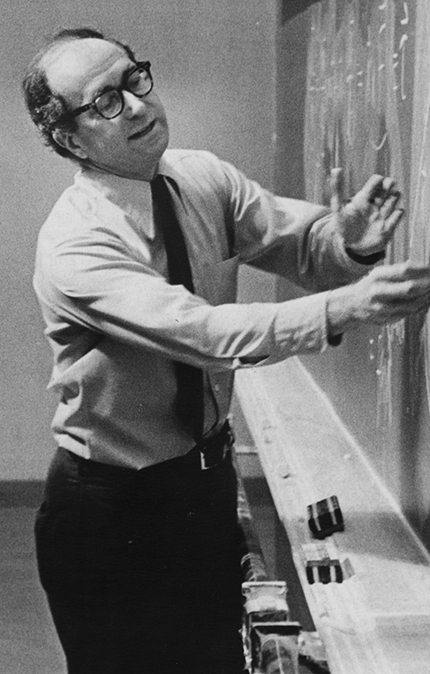Anthony Philip French
DOI: 10.1063/PT.3.3604
Anthony Philip French, MIT professor emeritus in physics, died on 3 February 2017. French was singularly committed to the importance of physics teaching, and he achieved wide recognition for his influence on the teaching of physics at MIT, his five highly respected textbooks, his role in international efforts to improve physics education, his contributions to ongoing debates about goals and purposes of physics teaching, and his leadership in the American Association of Physics Teachers (AAPT).

Anthony Philip French
MASSACHUSETTS INSTITUTE OF TECHNOLOGY

Born on 19 November 1920 and raised in Brighton, England, French started undergraduate work at Cambridge University in 1939 just as World War II began. His interest in nuclear physics was awakened by Egon Bretscher, a Swiss physicist teaching at Cambridge. After graduating in 1942, French was recruited by Bretscher into the Tube Alloys Project, Britain’s nuclear bomb program. In 1944 the program merged with the US’s Manhattan Project, and French was sent to Los Alamos. There, working for Edward Teller’s small group exploring the possibility of a fusion bomb, French measured cross sections for reactions of light nuclei, such as d + d → p + 3H and p + 3H → n + 3He. His results showed that a fusion bomb was in principle feasible.
Los Alamos was an unforgettable experience for French. He was 23 and barely educated in physics when he was suddenly removed from grim wartime Britain and set down in the scenic mountains of New Mexico, where he could have oranges and eggs and work with some of the best and most famous physicists in the world.
After the war, French married Naomi Livesay, a mathematician from Montana who worked in Richard Feynman’s computing group at Los Alamos. They honeymooned by touring the American Northwest in an auto bought from Klaus Fuchs—who was later discovered to have given atomic-bomb secrets to the USSR. French and his wife then moved to England, where he joined the Cambridge University faculty and completed his PhD using declassified results from his Los Alamos work.
In 1955 French moved to the University of South Carolina, and shortly afterwards he became physics department chair. Over the next six years, as he hired faculty to bring physics research into the department, his own interests shifted from research to teaching, and he wrote his first textbook, Principles of Modern Physics (Wiley, 1958).
His book was admired by Jerrold Zacharias, the MIT professor leading the Physical Science Study Committee (PSSC) effort to reform physics teaching in US high schools. Zacharias wanted to introduce the modern outlook of the PSSC into college and university physics teaching, and he recruited French to MIT to help do it.
French developed a novel curriculum for an experimental introductory physics course at MIT. When he proposed to expand his course to include a few more students from the regular course, the department head said, ”That’s of no use to me. Take the whole thing,” and French became the chief lecturer and manager of a course taken by more than 500 MIT students. Subsequently, he became associate head.
The acronym for French’s course became notorious. French said, “I called it, blandly, ‘Physics: A New Introductory Course.’ . . . Within the first week, I couldn’t imagine how I could have been so stupid, as it was known forever afterwards as the PANIC course!”
French was a skillful, lucid lecturer. Those qualities are also evident in his stylish writing. The four books he wrote while teaching PANIC are still in print. He used demonstrations well and devised several of his own. He was proud of his prize-winning pressure-of-light experiment and of his low-cost Fabry–Perot interferometer made from a microscope slide and a cover slip.
French’s influence in physics education reached beyond MIT. From 1975 to 1981, he was chairman of the International Commission on Physics Education (ICPE) of the International Union of Pure and Applied Physics. He edited Einstein: A Centenary Volume (Harvard University Press, 1979) and coedited Niels Bohr: A Centenary Volume (Harvard University Press, 1985). Those efforts on behalf of the ICPE were recognized with the 1980 University Medal of Charles University, Prague, and the 1988 Lawrence Bragg Medal and Prize of the Institute of Physics. AAPT also presented him with awards for his exceptional work: a Distinguished Service Citation in 1976 for US physics education; the Oersted Medal, its most prestigious award, in 1989 for the teaching of physics; and the Melba Newell Phillips Medal in 1993 for services to AAPT.
French retired from MIT in 1991 but remained active. In 1993 he directed the creation of the examinations for the XXIV International Physics Olympiad. He continued to speak and write about how to improve physics instruction, and until this year he regularly attended the physics department’s weekly luncheons.
More about the Authors
Peter H. Fisher. Massachusetts Institute of Technology, Cambridge.
Charles H. Holbrow. Colgate University, Hamilton, New York, Massachusetts Institute of Technology, Cambridge.




